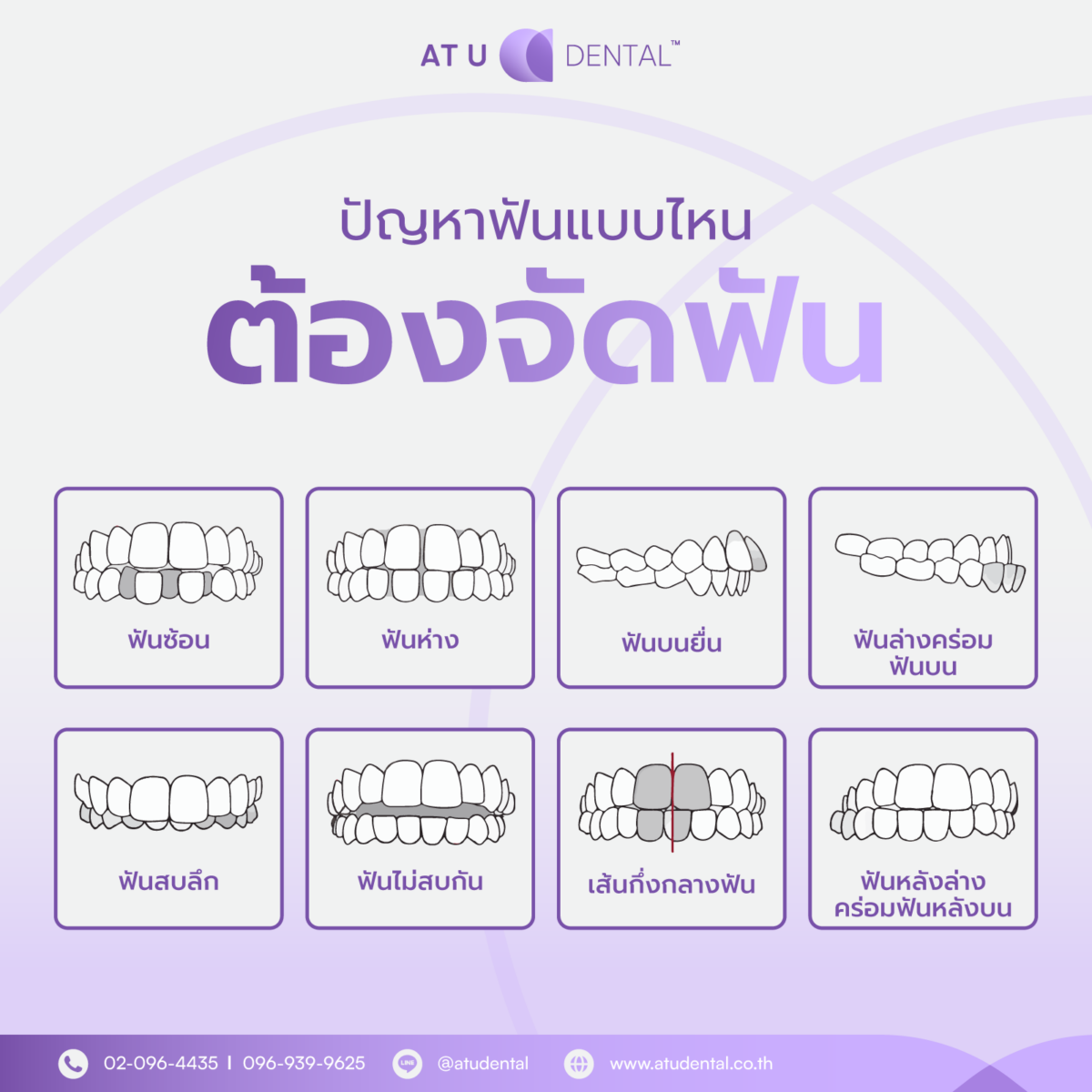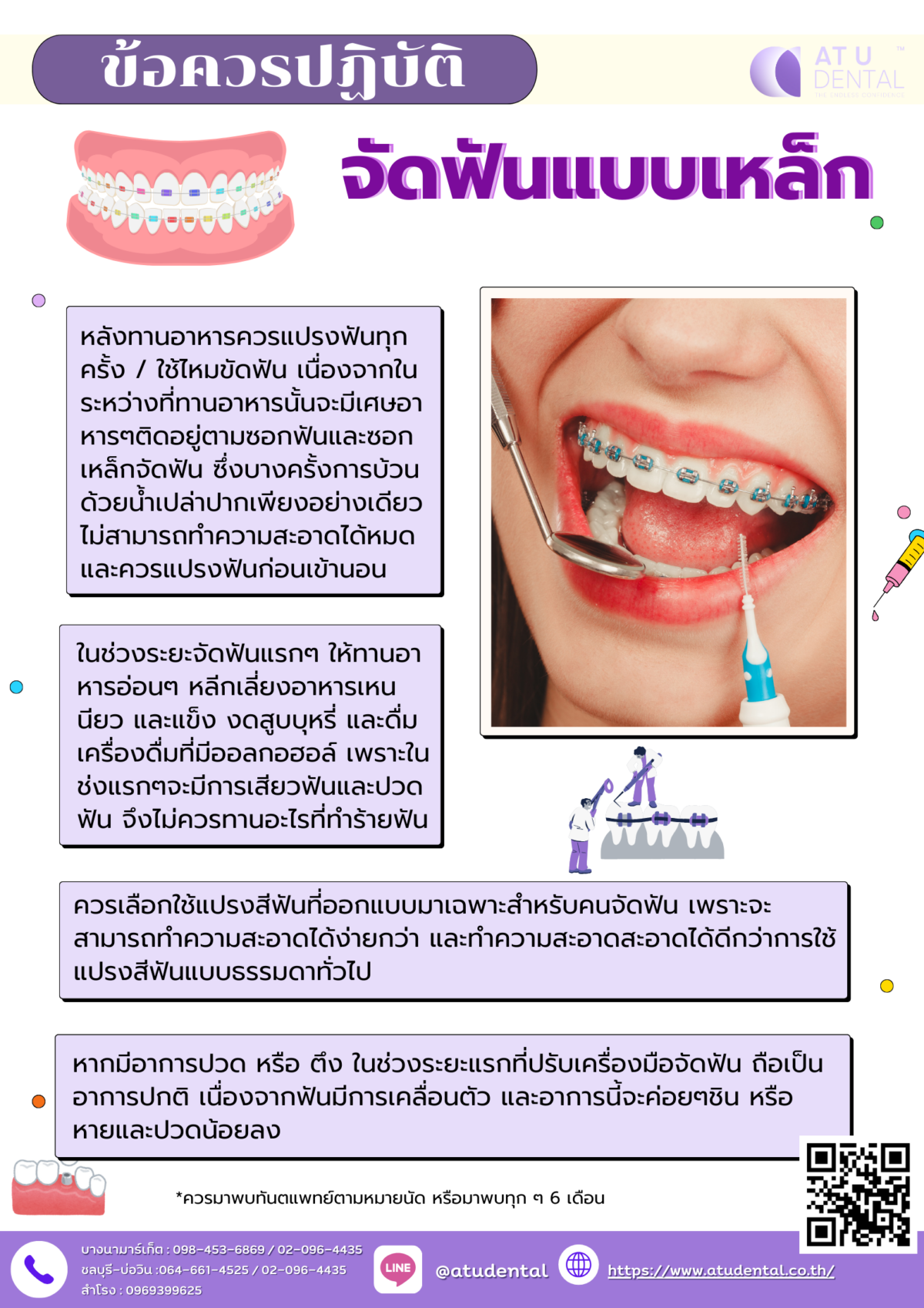Dental Clinic
คลินิคทันตกรรม
Metal Braces (Traditional Braces with Elastic Ligatures)
Metal braces, also known as traditional braces with elastic ligatures, are one of the most widely used orthodontic treatments. They are highly effective in correcting issues such as crowded teeth, gaps, and bite misalignment. This type of orthodontic treatment consists of metal brackets bonded to the teeth, the Bracket connected by an archwire, and secured with elastic ligatures (O-rings) to control tooth movement according to the treatment plan. Metal braces are suitable for individuals seeking long-term improvements in both oral health and dental aesthetics.

Indications for Metal Braces
- Crowded or misaligned teeth
- Gaps between teeth
- Malocclusion issues (e.g., overbite, underbite, crossbite)
- Difficulty in chewing food properly
- Excessive tooth wear due to improper bite alignment
- Gum inflammation caused by difficulty in cleaning misaligned teeth
Treatment Process
- Diagnosis and Preparation
- The dentist evaluates the teeth, using X-rays to assess alignment and bone structure.
- Dental impressions are taken to create a model for treatment planning.
- Braces Installation
- The dentist attaches the Bracket to each tooth
- Elastic ligatures (O-rings) help apply the necessary force to move the teeth.
- Regular Adjustments
- The dentist schedules check-ups every 4-6 weeks to adjust the wires and replace the elastic bands.
- Monitoring and Treatment Duration
- The total treatment time varies from 1 to 3 years, depending on the complexity of each case.
- Removal and Retainer Use
- Once the treatment is complete, the braces are removed, and retainers are provided to maintain the teeth’s new position.

Post-Treatment Care for Metal Braces
- Avoid hard, sticky, or crunchy foods to prevent damage to the braces.
- Brush thoroughly daily using a special orthodontic toothbrush.
- Use floss and interdental brushes to remove food debris.
- Attend regular dental visits to monitor progress and adjust braces as needed.
- Wear retainers as instructed to prevent teeth from shifting back.
Frequently Asked Questions (FAQ)
Q: How long does metal braces treatment take?
A: The average duration is 1 to 3 years, depending on the severity of the dental misalignment.
Q: Does getting metal braces hurt?
A: Some discomfort or soreness may occur, especially after initial placement or adjustments, but it gradually subsides.
Q: How often should I visit the dentist during treatment?
A: Regular check-ups are scheduled every 4-6 weeks for adjustments.
Q: Can I eat normally with braces?
A: Certain foods, such as popcorn, gum, and nuts, should be avoided to prevent damage.
Q: Will braces affect my speech?
A: Some minor speech adjustments may be needed initially, but adaptation happens quickly.
Q: Can teeth shift back after braces are removed?
A: Without proper retainer use, teeth may gradually shift back to their original position.
Q: What is the ideal age to get braces?
A: 12-14 years old is the typical age for orthodontic treatment, as most permanent teeth have erupted.
Q: Can adults get braces?
A: Yes! There is no age limit for orthodontic treatment, and many adults successfully undergo braces treatment.
Q: How much do metal braces cost?
A: Costs vary depending on complexity and treatment length, typically ranging between $900 - $2,500 (30,000-80,000 THB).
Q: Do I need to have teeth extracted before getting braces?
A: In some cases of severe crowding, tooth extraction may be recommended to create space for proper alignment.
Metal braces remain a highly effective orthodontic solution for correcting tooth misalignment and bite issues. Following the dentist’s instructions—**including proper oral hygiene, regular check-ups, and wearing retainers—**is essential for achieving long-lasting results and a confident smile.
Dental Treatment


